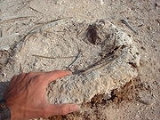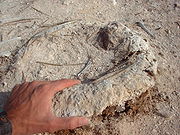
Peruvian Booby
Encyclopedia
The Peruvian Booby, Sula variegata, is an endemic bird of the Peruvian current whose distribution is restricted to the west coast of South America
from Punta Pariñas
(4.6°S) in Peru
to Concepción
in Chile
(Harrison 1988). It is the second most abundant seabird species that inhabits the Peruvian Coast and the second most important guano
-producing seabird. During the mid-twentieth century, the Peruvian Booby population reached 3 million birds (Tovar et al. 1987).
 After ENSO
After ENSO
1982-83, less than 0.2 million birds were left. Peruvian Booby population was recovering since 1984 and reached in 1996 more than 2.6 million birds. ENSO 1997-98 started after most boobies finished the breeding season and caused a southward migration of birds. The number of Peruvian Boobies in Peru decreased through 1997 in about 87.1% due to this reason, few birds were found dead along the coast.
Peruvian Boobies breed throughout the year. Main breeding season occurs during the austral spring-summer period (September to March) and most pairs may attempt to breed for a second time during the year depending on food availability. Peruvian Boobies clutch size varies from one to four eggs, but clutches of two or three eggs, pale blue in color, are usually found. Eggs are incubated during approximately 4 to 5 weeks, both adults share the nest attendance. The rearing period lasts about 3 months. Breeding success depends on food availability and is related to colony location, colony size
and timing of breeding.
South America
South America is a continent situated in the Western Hemisphere, mostly in the Southern Hemisphere, with a relatively small portion in the Northern Hemisphere. The continent is also considered a subcontinent of the Americas. It is bordered on the west by the Pacific Ocean and on the north and east...
from Punta Pariñas
Punta Pariñas
Punta Pariñas is the westernmost point in mainland South America, located at .Punta Pariñas is in Peru, in the La Brea District, Talara Province, Piura Region.An active lighthouse is located in Punta Pariñas...
(4.6°S) in Peru
Peru
Peru , officially the Republic of Peru , is a country in western South America. It is bordered on the north by Ecuador and Colombia, on the east by Brazil, on the southeast by Bolivia, on the south by Chile, and on the west by the Pacific Ocean....
to Concepción
Concepción, Chile
Concepción is a city in Chile, capital of Concepción Province and of the Biobío Region or Region VIII. Greater Concepción is the second-largest conurbation in the country, with 889,725 inhabitants...
in Chile
Chile
Chile ,officially the Republic of Chile , is a country in South America occupying a long, narrow coastal strip between the Andes mountains to the east and the Pacific Ocean to the west. It borders Peru to the north, Bolivia to the northeast, Argentina to the east, and the Drake Passage in the far...
(Harrison 1988). It is the second most abundant seabird species that inhabits the Peruvian Coast and the second most important guano
Guano
Guano is the excrement of seabirds, cave dwelling bats, and seals. Guano manure is an effective fertilizer due to its high levels of phosphorus and nitrogen and also its lack of odor. It was an important source of nitrates for gunpowder...
-producing seabird. During the mid-twentieth century, the Peruvian Booby population reached 3 million birds (Tovar et al. 1987).

Enso
Ensō is a Japanese word meaning "circle" and a concept strongly associated with Zen. Ensō is one of the most common subjects of Japanese calligraphy even though it is a symbol and not a character. It symbolizes the Absolute enlightenment, strength, elegance, the Universe, and the void; it can...
1982-83, less than 0.2 million birds were left. Peruvian Booby population was recovering since 1984 and reached in 1996 more than 2.6 million birds. ENSO 1997-98 started after most boobies finished the breeding season and caused a southward migration of birds. The number of Peruvian Boobies in Peru decreased through 1997 in about 87.1% due to this reason, few birds were found dead along the coast.
Peruvian Boobies breed throughout the year. Main breeding season occurs during the austral spring-summer period (September to March) and most pairs may attempt to breed for a second time during the year depending on food availability. Peruvian Boobies clutch size varies from one to four eggs, but clutches of two or three eggs, pale blue in color, are usually found. Eggs are incubated during approximately 4 to 5 weeks, both adults share the nest attendance. The rearing period lasts about 3 months. Breeding success depends on food availability and is related to colony location, colony size
Group size measures
Many animals, including humans, tend to live in groups, herds, flocks, bands, packs, shoals, or colonies of conspecific individuals. The size of these groups, as expressed by the number of participant individuals, is an important aspect of their social environment...
and timing of breeding.
External links
- Peruvian Booby on the Internet Bird Collection
- The Peruvian Booby
- Stamps (for PeruPeruPeru , officially the Republic of Peru , is a country in western South America. It is bordered on the north by Ecuador and Colombia, on the east by Brazil, on the southeast by Bolivia, on the south by Chile, and on the west by the Pacific Ocean....
-2 issues) with RangeMap - Peruvian Booby photo gallery VIREO

